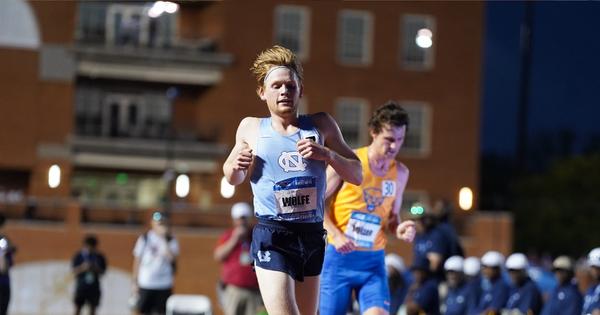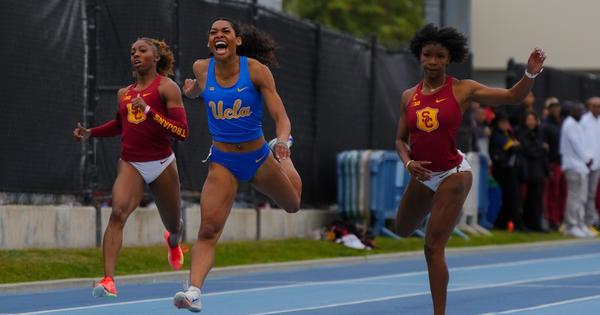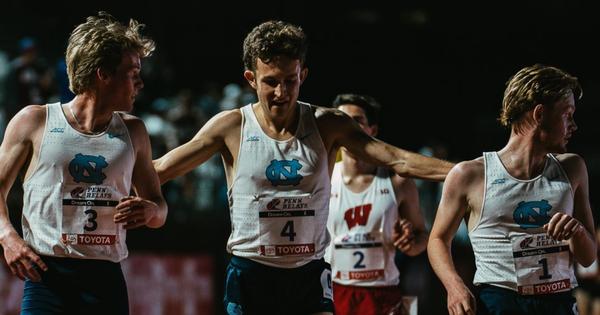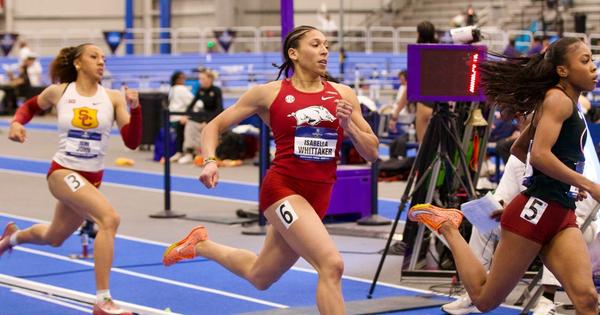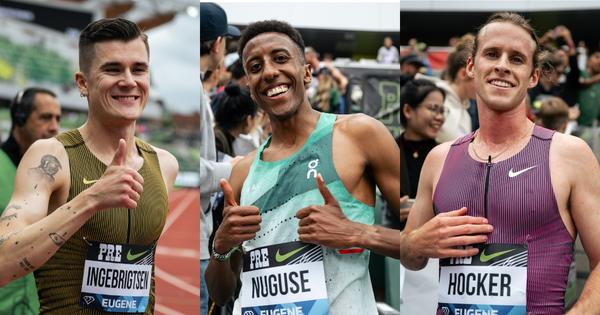By David Melly
May 21, 2025
For Lap Count readers observing the semi-permeable bubble of collegiate track and field from the outside looking in, the outdoor track season has taken a bit of a backseat these last few months.
Between spring marathons, the pros coming out of hibernation, and the start of Leagues and Slams, there’s a lot of non-NCAA track to focus on. Maybe a highlight from Penn Relays or Mykolas Alekna’s world record(s) in the discus broke through the noise, but generally speaking, the “regular” college track season isn’t always the most fun for fans to track… until now.
It’s hard to say whether conference championships mark the end of the regular season or the start of the postseason, but either way, they always seem to deliver the goods. Between dramatic 4x400m finishes and crazy tactical races, world-class sprint marks, and breakout freshman performances, all of a sudden it seems like there’s a lot more newsworthy content coming out of the collegiate ranks than anywhere else.
A few performances that really stood out: Jordan Anthony’s 9.95 100m/19.93 200m double victory at SECs, the latter of which came over Makanakaishe Charamba after the Auburn sprinter ran 19.92 in the prelims. The women of USC put on a clinic in sprint dominance at Hayward Field for Big Tens, finishing 1-2-3 in the 100m, 1-2-3-4 in the 200m, and 1-2 in the 400m. And remember the name Micahi Denzy: after missing NCAA indoors entirely, the true freshman at Florida State improved his two-week-old 400m PB from 45.00 to 44.38 in one race at ACCs and all of a sudden looks like the favorite in the event for the outdoor championship.
It was a good weekend for steeplechasers as Doris Lemngole picked up the 5000m/3000m steeplechase double win in 15:11.62/9:20.83, the latter of which she took by 33 seconds. Across the country in Kansas, BYU Olympian James Corrigan pulled off a similar performance with a pair of victories (8:22.20/13:25.40) of his own. Distance runners and their coaches around the country are likely breathing a sigh of relief that these two can’t pull the same points-gobbling arrangement due to the NCAA schedule.
But it’s not just individually impressive performances that make conference weekend exciting. Conference championships deliver a perfect combo of three important things that make watching track and field exciting. A few of them may sound familiar, since they’re features the pro track world is constantly trying to manufacture—but they already exist on the collegiate level!
Stakes: Until GST or some other interloper fully disrupts the slow, progressive track and field schedule, outdoor conference weekend still holds the honor of being the first spring meets that feel like they really matter. Until you can put “NCAA champion” or “Olympian” in front of your name, earning a title like “ACC champ” is a succinct, sticky way to tout your athletic accomplishments.
After weeks or months of coaches entering their athletes in off events and holding big stars back, everyone actually has to show up and compete their hardest. Why? Because even with the ever-shifting landscape of conference participation, every program in the country really does want to win a team title and will pull out all the stops to give them the best shot. Instead of carefully-measured early season efforts, you get steeplers and 10K runners doubling back to the 5000m and athletes like Clemson’s Gladys Chepngetich pulling an 800m/1500m/4x400m triple, the former of which she won in 1:59.94 ahead of the likes of Roisin Willis, Makayla Paige, and Lindsey Butler.
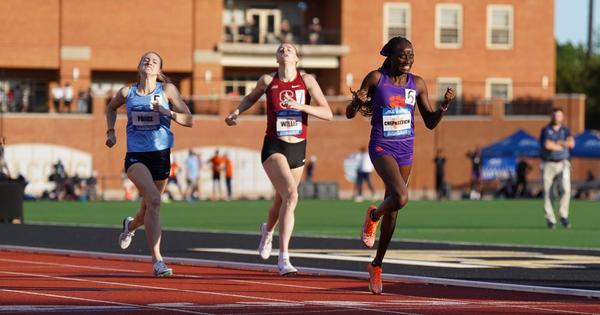
Gladys Chepngetich, Roisin Willis, Makayla Paige | Photo by Alex Halloway / @fna_halloway
Unlike in Who’s Line Is It Anyway, in conference meets, the points do matter. It can be hard to compare relative performances across disciplines, but 10 points in the pole vault is inarguably more than 8 points in the hurdles. It would’ve been pretty impressive to see the men of Wisconsin rack up 21 points in the 5000m at Big Tens… had Oregon not scored a whopping 23 in the men’s 10,000m two days prior. And there’s nothing better than when a team title comes down to the 4x400m, as it did in the ACC women’s competition where UVA led Louisville by one measly point heading into the final event and still emerged victorious after finishing sixth to the Cardinals’ tenth-place effort.
It’s no wonder that Grand Slam Track has built its competition model around the idea of scoring: a points race really is the simplest, most universal way to track and quantify the outcomes of the widely-varied competition styles and formats of each individual event within track and field. And taking home a big-ass trophy is a clear way to show the guys on the lacrosse team what track and field means to your school.
Rivalries: They may have shed the “Pacific” branding, but there’s something awfully familiar about watching Oregon and Washington runners battle to the finish line in Hayward Field. While the national conference realignment has created some strange outcomes and new dynamics, the opportunity to reignite old rivalries and develop new ones is a critical part of in-conference competition. While they held their conference championships a week earlier, Cornell Big Red fans of all ages surely appreciated the redux of a classic UW-UO moment when Derek Amicon pipped Princeton’s Marcelo Parra Ramon at the line in the steeplechase after Ramon celebrated early. (In fairness, Princeton scored 15 points to Cornell’s 10 in the event and swept the men’s and women’s team titles at Heps.)
With the arrival of Stanford and the ascendance of UNC, the ACC is quickly becoming the best middle-distance conference in the NCAA. This weekend, Chris Miltenberg’s new team got the best of his old one, as Ethan Strand outkicked Leo Young (and Cal’s Garrett MacQuiddy) to win the 1500m then doubled back to a runner-up finish behind teammate Parker Wolfe in the 5000m, where both ‘Heels finished ahead of Cole Sprout. Along with Wolfe’s win in the 10,000m, the dynamic duo in baby blue racked up 38 of UNC’s 82 points in their second-place team performance.
And then, of course, there was the cross country dual meet Big Ten 10,000m final. Oregon and Washington successfully shut out every other team from the scoring, splitting the top eight places between Washington’s 1-5-7 finish led by Evan Jenkins’s 29:24.48 title and Oregon’s 2-3-4-6-8 clinic. For the PNW residents who miss the famous Border Clash cross-country meet, this was a thrilling on-track recreation—albeit not quite as visually dramatic a start.
Tactics: One of the main reasons why the NCAA is considered a strong feeder system for international competition is that collegiate runners—especially in the distance events—are forced via trial-by-fire to learn a lot of hard lessons about navigating championship races with different tactics and styles.
There’s the classic 1500m-jog-into-sprint, like the Big Ten men’s 1500m final where Adam Spencer led the top six finishers under 52 seconds over the final 400m to win in 3:53.18. There’s the pure chaos of an overcrowded 5000m final. And while it’s technically not a tactical performance, everyone loves a come-from-behind relay leg, like Nathaniel Ezekiel’s fourth-to-first 44.12 split for Baylor at Big 12s.
Athletes are forced out of the comparative comfort zone of rabbited races and into all manner of strange and unpredictable circumstances. At most conference meets, the 5000m’s placement at the end of the program means that 10K, 1500m, and steeplechase runners are all meeting up on tired legs, clamoring for whatever points they can muster for their team. This arrangement can yield all sorts of crazy results. For the sprinters, the combination of ambitious doubles and multiple rounds of racing serves as great preparation for anyone who wants to rack up medals one day on the global championship scale. And with 100m/200m winning times frequently under 10 seconds, 11 seconds, 20 seconds, or 22 seconds, respectively, the SEC championships are often one of the best sprint competitions anywhere in the world regardless of level.
In a sport where pre-summer excitement can sometimes be hard to find, conference weekend delivers the thrills and spills every time. The narratives are authentically dramatic, not manufactured, and the outcomes are satisfyingly elite. It’s hard to perfectly replicate in other events, but for now, let’s not take what we already have for granted.

David Melly
David began contributing to CITIUS in 2018, and quickly cemented himself as an integral part of the team thanks to his quick wit, hot takes, undying love for the sport and willingness to get yelled at online.
